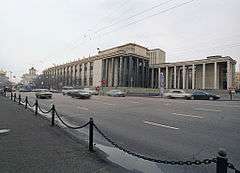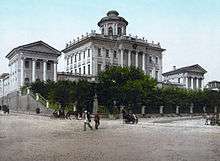Russian State Library
- Not to be confused with the Russian National Library
 Whole view of Russian State Library | |
| Established | 1862[1] |
|---|---|
| Location | Moscow, Russia |
| Branches | 3 |
| Collection | |
| Size | 44,800,000 (2012) |
| Access and use | |
| Population served | 93,100 (2012) |
| Other information | |
| Budget |
|
| Director | Alexander I. Visly (General Director), Vladimir I. Gnezdilov (Executive Director), Viktor V. Fiodorov (President) [1] |
| Staff | 1830 (2012) |
| Website | http://www.rsl.ru/en |
The Russian State Library (Russian: Российская государственная библиотека) is the national library of Russia, located in Moscow. It is the largest in the country and the fourth largest in the world for its collection of books (17.5 million).[2] It was named the V. I. Lenin State Library of the USSR from 1925 until it was renamed in 1992 as the Russian State Library.
The library has over 275 km of shelves with more than 43 million items,[1] including over 17 million books and serial volumes, 13 million journals, 350 thousand music scores and sound records, 150,000 maps and others. There are items in 247 languages of the world, the foreign part representing about 29 percent of the entire collection.
Between 1922 and 1991 at least one copy of every book published in the USSR was deposited with the library, a practice which continues in a similar method today, with the library designated by law as a place to hold a "mandatory" copy of every publication issued in Russia.
History
The library was founded on July 1, 1862, as Moscow's first free public library named The Library of the Moscow Public Museum and Rumiantsev Museum, or The Rumiantsev Library. It is nicknamed the "Leninka."[3] Rumyantsev Museum part of the complex was Moscow's first public museum, and housed the Art collection of count Nikolai Petrovich Rumyantsev, which had been given to the Russian people and transferred from St. Petersburg to Moscow. Its donation covered above all books and manuscripts as well as an extensive numismatic and an ethnographic collection. These, as well as approximately 200 paintings and more than 20,000 prints, which had been selected from the collection of the Hermitage in St. Petersburg, could be seen in the so-called Pashkov House (a palace, established between 1784 and 1787, in the proximity of the Kremlin). Tsar Alexander II of Russia donated the painting The Appearance of Christ before the People by Alexander Andreyevich Ivanov for the opening of the museum.

The citizens of Moscow, deeply impressed by the count's altruistic donation, named the new museum after its founder and had the inscription "from count Rumyantsev for the good Enlightenment" carved above its entrance. In the subsequent years, the collection of the museum grew by numerous further donations of objects and money, so that the museum soon housed a yet more important collection of Western European paintings, an extensive antique collection and a large collection of icons. Indeed, the collection grew so much that soon the premises of the Pashkov House became insufficient, and a second building was built beside the museum shortly after the turn of the 20th century to house the paintings in particular. After the October Revolution the contents again grew enormously, and again lack of space became an urgent problem. Acute financial problems also arose, for most of the money to finance the Museum flowed into the Pushkin Museum, which had only been finished a few years before and was assuming the Rumyantsev Museum's role. Therefore, it was decided in 1925 to dissolve the Rumyantsev Museum and to spread its collections over other museums and institutions in the country. Part of the collections, in particular the Western European art and antiques, were thus transferred to the Pushkin Museum. Pashkov House (at 3 Mokhovaya Street) was renamed the Old Building of the Russian State Library. The old state archive building on the corner of Mokhovaya and Vozdvizhenka Streets was razed and replaced by the new buildings.
Construction of the first stage, designed by Vladimir Shchuko and Vladimir Gelfreikh in 1927–1929, was authorized in 1929 and commenced in 1930.[4] The first stage was largely complete in 1941. In the process, the building acquired the modernized neoclassicism exterior features of the Palace of Soviets (co-designed by Shchuko and Gelfreikh), departing from the stern modernism of the 1927 drafts.[5] The last component of Shchuko's plan, a 250-seat reading hall, was opened in 1945; further additions continued until 1960.[6] In 1968 the building reached its capacity, and the library launched construction of a new depository in Khimki, earmarked for storing newspapers, scientific works and low-demand books from the main storage areas. The first stage of Khimki library was complete in 1975.[6]
In 1925 the complex was renamed the V. I. Lenin State Library of the USSR. In 1992, it was renamed the Russian State Library by order of a decree from President Boris Yeltsin.[7]
Footnotes
- 1 2 3 "Russian State Library". Official library website. Retrieved 20 November 2010.
- ↑ http://leninka.ru/index.php?doc=2661
- ↑ "Russian State Library". Retrieved 2 April 2014.
- ↑ "History of the Russian State Library (in Russian). 1917–1941, p. 4". Retrieved 2008-12-10.
- ↑ Ikonnikov, A. V. (1984). Architecture of Moscow, 20th Century. [Arkhitektura Moskvy. XX vek] (in Russian). Moskovsky Rabochy. pp. 98–99.
- 1 2 "History of the Russian State Library (in Russian). 1945–1992, p. 1". Archived from the original on 2008-02-24. Retrieved 2008-12-10.
- ↑ Stuart, Mary (April 1994). "Creating a National Library for the Workers' State: The Public Library in Petrograd and the Rumiantsev Library under Bolshevik Rule". The Slavonic and East European Review. 72 (2): 233–258.
Further reading
- Edward Kasinec, "A Soviet Research Library Remembered," Libraries & Culture, vol. 36, no. 1 (Winter 2001), pp. 16–26. In JSTOR.
External links
| Wikimedia Commons has media related to Russian State Library. |
- Official website
- Satellite image of the Russian State Library, centered on the main entrance
- Made in Russia: Russian State Library
Coordinates: 55°45′07″N 37°36′35″E / 55.75194°N 37.60972°E